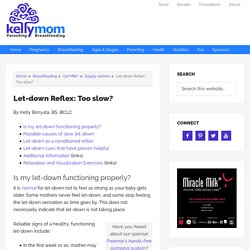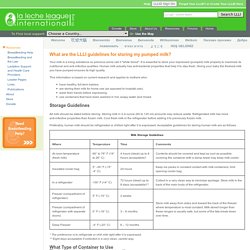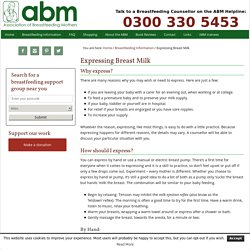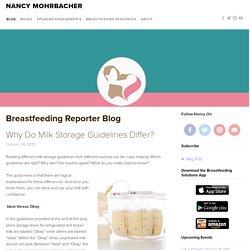

Cup_feeding.
Let-down Reflex: Too slow? By Kelly Bonyata, BS, IBCLC Is my let-down functioning properly?

It is normal for let-down not to feel as strong as your baby gets older. Some mothers never feel let-down, and some stop feeling the let-down sensation as time goes by. This does not necessarily indicate that let-down is not taking place. Reliable signs of a healthy, functioning let-down include: In the first week or so, mother may notice uterine cramping during letdown.Baby changes his sucking pattern from short and choppy (like a pacifier suck) at the beginning of the feeding to more long, drawing, and rhythmic a minute or so into the feeding.Mother may have a feeling of calm, relaxation, sleepiness or drowsiness.Mother may have a strong sensation of thirst while breastfeeding.Baby is swallowing more often.
Occasionally, mothers will also experience other symptoms during let-down, including itching, nausea, headaches, or negative emotions. Possible causes of slow let-down Let-down as a conditioned reflex In Pavlov’s terms: Maximizing Milk Production. To Pump More Milk, Use Hands-On Pumping — Nancy Mohrbacher. For premature babies, mother’s milk is like a medicine.

Any infant formula these babies receive increases their risk of serious illness, so these mothers were under a lot of pressure to pump enough milk to meet their babies’ needs. Amazingly, when these mothers used their hands as well as their pump to express milk, they pumped an average of 48 percent more milk than the pump alone could remove.
According to another study, this milk also contained twice as much fat as when mothers used only the pump. According to previous research, in most mothers exclusively pumping for premature babies, milk production falters after three to four weeks. But the mothers using this “hands-on” technique continued to increase their milk production throughout their babies’ entire first eight weeks, the entire length of the study. Hands-on pumping is not just for mothers with babies in special care. 1. 2. 3. 4. This entire routine took the mothers in the study an average of about 25 minutes. The Baby Friendly Initiative. Breast Milk Hand Expression (with audio) - Breast Time of Life.
Hand Expression - Newborn Nursery at LPCH - Stanford University School of Med... What are the LLLI guidelines for storing my pumped milk? Your milk is a living substance so precious some call it "white blood".

It is essential to store your expressed (pumped) milk properly to maximize its nutritional and anti-infective qualities. Human milk actually has anti-bacterial properties that help it to stay fresh. Giving your baby the freshest milk you have pumped ensures its high quality. This information is based on current research and applies to mothers who: have healthy, full-term babies;are storing their milk for home use (as opposed to hospital use);wash their hands before expressing;use containers that have been washed in hot, soapy water and rinsed.
Storage Guidelines All milk should be dated before storing. Preferably, human milk should be refrigerated or chilled right after it is expressed. . * The preference is to refrigerate or chill milk right after it is expressed. ** Eight days acceptable if collected in a very clean, careful way. What Type of Container to Use The best options for storing human milk: Expressing Breast Milk - Association of Breastfeeding Mothers. Why express?

There are many reasons why you may wish or need to express. Here are just a few: If you are leaving your baby with a carer for an evening out, when working or at college.To feed a premature baby and to preserve your milk supply.If your baby, toddler or yourself are in hospital.For relief if your breasts are engorged or you have sore nipples.To increase your supply. Whatever the reason, expressing, like most things, is easy to do with a little practice. Because expressing happens for different reasons, the details may vary. How should I express? You can express by hand or use a manual or electric breast pump. Begin by relaxing. By Hand: Stimulate hormone release: Massage your breast in a circular manner. Why Do Milk Storage Guidelines Differ? — Nancy Mohrbacher. Is your baby healthy?

These guidelines are intended for full-term, healthy babies at home. If your baby is hospitalized, your hospital’s milk storage guidelines are likely shorter than these. Preterm and sick babies are more vulnerable to illness, so pumping and storing recommendations may be stricter. How much expressed milk does your baby get? If your baby gets most of her milk directly from your breasts, you don’t need to worry about whether the small amount of expressed milk she gets is fresh, refrigerated, or previously frozen. Milk Storage Times for Full-term Healthy Babies at Home Room Temperature (66°F-72°F/19°C-22°C) • Fresh, never frozen: 6-10 hr • Frozen then thawed: 4 hr • Frozen then thawed, warmed but not fed: Until feeding ends • Frozen then thawed, warmed and fed: Until feeding ends Room Temperature (73°F–77°F/23°C–25°C) • Fresh, never frozen: 4 hr • Frozen and thawed, warmed but not fed: Until feeding ends Insulated Cooler with Ice Packs.